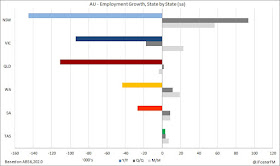Labour Force Survey — July | By the numbers
- Employment on net lifted by 114.7k in July (seasonally adjusted); well ahead of the median estimate for a 30.0k rise. Employment in June was revised to show a larger gain of 228.4k from the 210.8k reported initially.
- Headline unemployment increased from 7.45% to 7.49% in July; lower than the 7.8% level expected by markets. Underemployment declined by 0.46ppt to 11.22% and underutilisation came down by 0.41ppt to 18.72%.
- The participation rate advanced by 0.6ppt to 64.66% to be up by 2ppts from the low in May.
- Aggregate hours worked were up by a further 1.3% in July to 1.68bn hours after rebounding by 4.2% in June, though that still leaves the level down by 5.5% pre-pandemic.
Labour Force Survey — July | The details
With Australia's reopening on track through June into July, the labour market made a solid start to its recovery. Following the return of 228.4k jobs in June, a further 114.7k jobs were restored in July. Taken together, the initial phase of the reopening was able to claw back 343.1k (or around 39%) of the 871.5k jobs that were lost ahead of and during the shutdown through April and May. A better compositional mix came through in July with part-time employment rising by 71.2k and full-time jobs up by 43.5k, whereas in June this was lopsided with part-time up 252.0k and full-time falling 23.6k. Still, the damage done has been hugely significant with part-time employment down by 210.5k and full-time work lower by 317.9k from their pre-pandemic levels.
The positive in today's report was the confirmation that the rebound generated by the reopening in June was able to carry over into July as employment and hours worked added to their gains in the prior month. A lot has since changed post the reference period for the July survey with Victoria being placed back in shutdown after a surge in new virus cases. This will be a jolt the continuation of the national recovery, though the Federal Government has responded by extending its key fiscal measures and the RBA has recently restarted its bond purchases so significant policy support remains in place.
With Australia's reopening on track through June into July, the labour market made a solid start to its recovery. Following the return of 228.4k jobs in June, a further 114.7k jobs were restored in July. Taken together, the initial phase of the reopening was able to claw back 343.1k (or around 39%) of the 871.5k jobs that were lost ahead of and during the shutdown through April and May. A better compositional mix came through in July with part-time employment rising by 71.2k and full-time jobs up by 43.5k, whereas in June this was lopsided with part-time up 252.0k and full-time falling 23.6k. Still, the damage done has been hugely significant with part-time employment down by 210.5k and full-time work lower by 317.9k from their pre-pandemic levels.
With the reopening allowing jobs to come back to the economy, hours worked have risen by 5.5% off the low point that came in May. However, there is still a long way to go because the shutdown saw hours worked contract by 10.4% between March and May. Even after the improvements in June (+4.2%) and July (+1.3%), total hours worked are still down by 5.5% from their pre-pandemic level.
The boost in hours worked generated by the reopening has helped to lower Australia's rates of underemployment and underutilisation from their April peaks to 11.2% and 18.7% respectively. The ABS also reported a fall in the number of Australians working zero hours due to economic reasons in July to 165.8k from 232.1k in the month prior, though around 120.0k of those who worked zero hours in June moved to not being employed this month (note these workers do not necessarily become classified as unemployed). The unemployment rate was contained at around 7.5%, which was a better-than-expected result considering the level of workforce participation lifted sharply to around 64.7% reflecting the return of some mutual obligation requirements linked with the JobSeeker support payment. However, the unemployment rate still understates the scale of the dislocation as the chart below shows and is also being held down by the Federal Government's JobKeeper policy.
The state employment outcomes are shown in the next chart. After seeing the largest hit from the shutdown, New South Wales has led on the way back to drive the national recovery. Ahead of the reversal of its reopening, Victoria had only seen a modest rebound in employment of 52.4k after 198.1k jobs were lost between April and May.
Labour Force Survey — July | Insights







